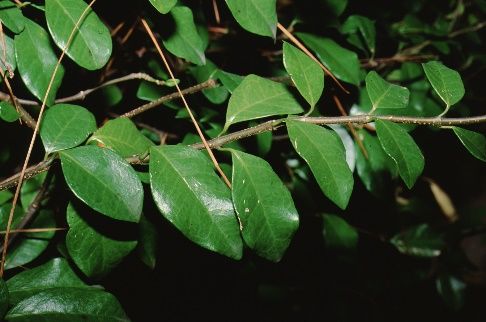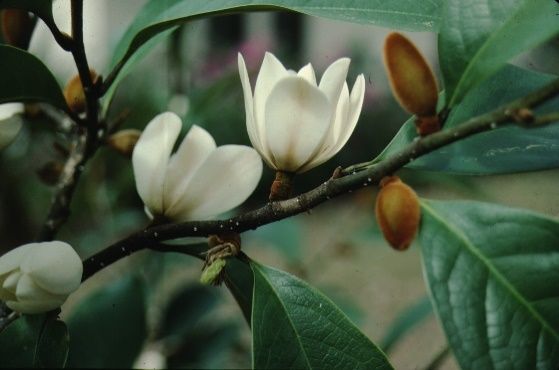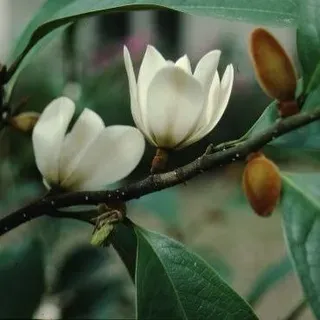Michelia doltsopa x figo 'Allspice' Allspice Banana Shrub
Introduction
This selection of banana shrub is a dense, upright, evergreen shrub when young that eventually forms a rounded canopy. It attains a height of 10 to 15 feet in sunny locations with lustrous, dark-green foliage with thick brown hairs on the underside. Brown hairs cover the green twigs so densely that the twigs appear brown. The fragrant, 1½ inch diameter, light-yellow flowers are edged in maroon and are magnolia-like in appearance. They last from spring until early summer and have a very interesting fragrance; they smell like ripening cantaloupes or bananas. This smell can be very pleasant but can be overwhelming when these shrubs are massed together. The bark of the banana shrub becomes a dark grayish-brown color with age.

Credit: Edward F. Gilman, UF/IFAS

Credit: Edward F. Gilman, UF/IFAS

Credit: Edward F. Gilman, UF/IFAS
General Information
Scientific name: Michelia doltsopa x figo 'Allspice'
Pronunciation: my-KEEL-lee-uh dolt-SOE-puh FYE-go
Common name(s): 'Allspice' banana shrub
Family: Magnoliaceae
Plant type: shrub
USDA hardiness zones: 9 through 10 (Figure 4)
Planting month for zone 9: year-round
Planting month for zone 10: year-round
Origin: not native to North America
Invasive potential: not known to be invasive
Uses: near a deck or patio; specimen; espalier; screen; border
Availability: somewhat available, may have to go out of the region to find the plant

Credit:
Description
Height: 10 to 20 feet
Spread: 6 to 15 feet
Plant habit: upright
Plant density: dense
Growth rate: moderate
Texture: medium
Foliage
Leaf arrangement: alternate
Leaf type: simple
Leaf margin: entire
Leaf shape: oblong
Leaf venation: pinnate
Leaf type and persistence: evergreen
Leaf blade length: 4 to 8 inches
Leaf color: green
Fall color: no fall color change
Fall characteristic: not showy
Flower
Flower color: yellow
Flower characteristic: pleasant fragrance; spring flowering
Fruit
Fruit shape: oval
Fruit length: less than 0.5 inch
Fruit cover: dry or hard
Fruit color: red
Fruit characteristic: inconspicuous and not showy
Trunk and Branches
Trunk/bark/branches: not particularly showy; typically multi-trunked or clumping stems; can be trained to grow with a short, single trunk
Current year stem/twig color: brown
Current year stem/twig thickness: medium
Culture
Light requirement: plant grows in part shade/part sun
Soil tolerances: acidic; sand; loam; clay
Drought tolerance: moderate
Soil salt tolerances: unknown
Plant spacing: 36 to 60 inches
Other
Roots: usually not a problem
Winter interest: no special winter interest
Outstanding plant: plant has outstanding ornamental features and could be planted more
Pest resistance: very sensitive to one or more pests or diseases which can affect plant health or aesthetics
Use and Management
Banana shrub is generally used as a specimen and foundation plant and is well suited for planting in a large container or raised planter. Older plants can be trained into small, multi-trunked trees. It is quite urban tolerant.
Banana shrub prefers a well-drained, acid, organic soil that is of medium fertility and moisture. It grows well in full sun to a mostly shaded location. Shaded plants grow taller than sun-grown plants and develop a central leader with little pruning, whereas sun-grown plants often develop several trunks with a rounded canopy.
Propagate this plant by cuttings because the seeds are nonviable.
Pests and Diseases
Banana shrub is relatively free of any pests or diseases. However, scales and mushroom rot may become a problem. A scale infestation can cause some defoliation.



